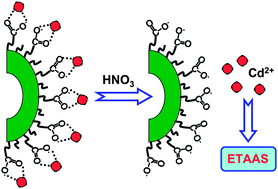A novel green/biodegradable adsorbent, mungbean-coat, has been investigated for the adsorption of ultra-trace amounts of cadmium. Carboxylic groups on the bean-coat effectively retain the cadmium ions via coordinative interactions. This well facilitates the adsorption of cadmium ions which can readily be recovered by acid elution. In practice, bean-coat is used to pack a mini-column for on-line adsorption and preconcentration of cadmium from environmental samples with detection by electrothermal atomic absorption spectrometry. By using a sample loading volume of 1.4 mL and an eluent volume of 70 μL, an enrichment factor of 19.8 along with a detection limit of 1.4 ng L−1 are achieved. A precision of 2.4% RSD at the level of 0.05 μg L−1 is derived. The present procedure has been applied for the determination of cadmium in certified reference materials (GBW08608 Trace Elements in Water and CRM 176 Trace Elements in a City Waste Incineration Ash) and a snow water sample. Fair agreements are reached between the certified values and the experimental results, in addition to a satisfactory spiking recovery for the snow water sample. In the present work, the use of green and biodegradable adsorbent as well as the elimination of use of organic solvent/eluent facilitates the development of a green analytical protocol.

You have access to this article
 Please wait while we load your content...
Something went wrong. Try again?
Please wait while we load your content...
Something went wrong. Try again?


 Please wait while we load your content...
Please wait while we load your content...